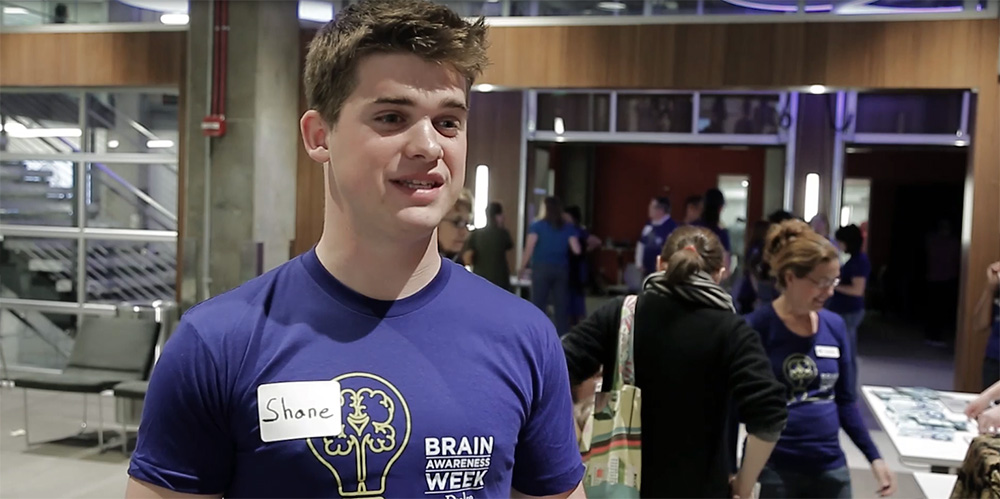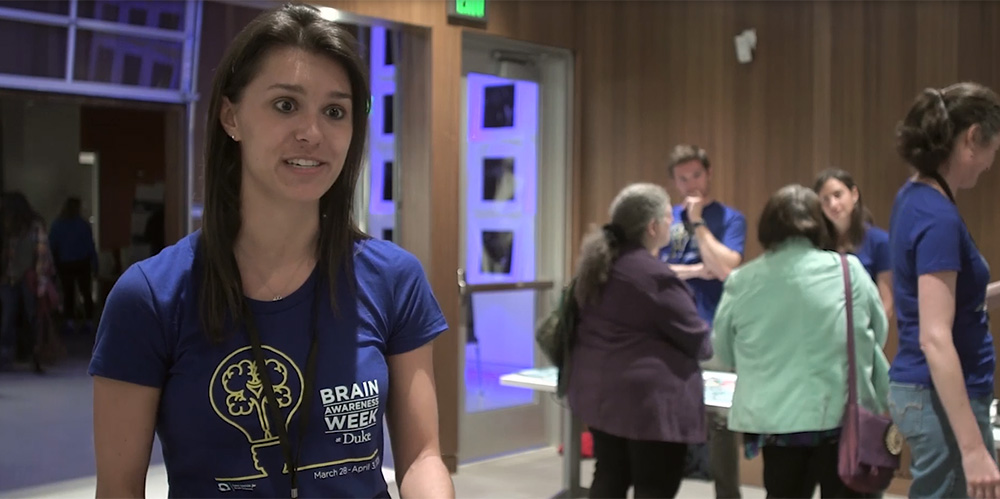From Lab to Museum, Students Share Their Brain Research
September 14, 2016
Bass Connections in Brain & Society teams explore the neuroscience of cognition, emotions, expression and decision-making to tackle complex societal challenges and increase our understanding of what makes us human.
Last year, interdisciplinary teams of faculty, graduate students and undergraduates took on topics as diverse as music and dementia, face perception and art, eye tracking and concussions, smoking and brain development, and lemurs and decision-making, to name a few. Team members developed surveys and interventions, curated an exhibition, conducted studies, presented their work at conferences, created websites and videos, gave public talks and completed honors theses.
Students translated their teams’ research for the public during the Duke Institute for Brain Sciences’ Brain Awareness Week.

Art, Vision and the Brain focuses on the premise that art and neuroscience, and science and the humanities in general, are working together to answer similar questions. For humans, faces are very important things. So our team worked on grappling with and understanding face perception through art and using it as a means to further our understanding of neuroscience. —Anuhita Basavaraju ’18, Art, Vision and the Brain
- Related outcome: Making Faces at the Intersection of Art and Neuroscience (exhibition catalogue by Monica Huerta, Elizabeth Johnson, Eleonora Lad, Jeff MacInnes, Guillermo Sapiro, Marianne Wardle, Kaitlin Henderson, Anuhita Basavaraju, Peter Cangialosi, Sophie Katz, Eduardo Salgado, Christopher Yoo. 2016. Durham, NC: Nasher Museum of Art.)

We’re working with people with dementia who are living in the Durham community. We go out and meet with them, do some baseline measurements and assess their cognition and their neuropsychiatric behaviors associated with dementia. We also talk with their caregivers. Then we ask them what kind of music they like, and we come back with their favorite music personalized on an iPod. We ask them to listen to their personalized music every day, and we try to see if there were any changes with their neuropsychiatric symptoms—and also with the caregiver burden associated with caring for someone with dementia. — Megan Snyder ’17, Music and Memory in the Aging Brain
- Related outcome: Personalized Music in Adults with Dementia: Effects on Caregivers (poster by Megan Snyder, Amanda Lee, Cole Jenson, Gabriela Gomez, Heidi White, Tobias Overath and Cassandra M. Germain presented at the Society for Post-acute and Long-term Care Medicine conference, Orlando, FL, March 2016)

One of the ways that Alzheimer’s has been diagnosed is through what’s called amyloid plaques, and this is done postmortem and has been thought to be one of the causal problems of Alzheimer’s. More recent research has shown that this most likely isn’t true, and it’s more of a symptom. So what I’m looking at is the precursor to this plaque and how it’s getting clogged in the mitochondria. I feel like I’ve probably learned more biochemistry through two or three semesters just working in this lab versus taking a class. —Shane Bierly ’16, Brain-immune Interactions in Neurodegenerative Disease
- Related outcome: A Novel Method for Examining APP Arrest in the TOM Complex (Shane Bierly, honors thesis for graduation with distinction in Neuroscience)

Our project is focused on using eye-tracking tests as an objective assessment for mild traumatic brain injury, also known as concussions. We’re hoping that these tests will provide us with more information about concussive events that may occur during a contact sport such as football. —Elizabeth Ginalis ’16, Oculomotor Response as an Objective Measurement for Mild Traumatic Brain Injury in the Pediatric Population
- Related outcome: Differences in Performance on the Antisaccade Task in Football Athletes during Childhood and Late Adolescence (poster by Elizabeth E. Ginalis, Chalette M. Lambert, Jason F. Luck, Kaustav P. Shah, Isabel V. Lake, Hattie C. Cutcliffe, Daniel J. O’Connell, Christopher P. Eckersley, Allen W. Yu, Jason R. Kait, Amitha Gade, Adam Mehlenbacher, Cameron R. “Dale” Bass)
Other Brain & Society teams last year included:
- Aging and Heuristics: Do Older Adults Use Different Cues to Evaluate Information?
- Environmental Effects on Cognitive Development
- Generosity and Gratitude: Mechanisms, Motivations and Models of Living Kidney Donation
- Look Before You Leap! Using Eye Tracking to Understand the Evolution of Locomotor Decision-making
- Movement, Grace and Embodied Cognition
- Neuroplicity: Leveraging New Media and Digital Storytelling to Connect Society to Neuroscience
Learn More
- Watch the video and find out how to get involved in Bass Connections.
The Franklin Humanities Institute provided additional support for Art, Vision and the Brain and Movement, Grace and Embodied Cognition. The Silver Family Kenan Institute for Ethics Fund in Support of Bass Connections provided additional support for Generosity and Gratitude: Mechanisms, Motivations and Models of Living Kidney Donation.
